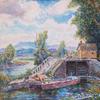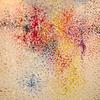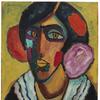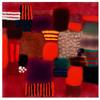THE CLARK HULINGS FUND NAMES FIRST TWO GRANT RECIPIENTS
- NEW YORK, New York
- /
- December 06, 2013
The Clark Hulings Fund For Burgeoning Visual Artists is pleased to announce that Lydia Musco and Lauren Frances Adams, two emerging artists, have been named the Fund’s first grant winners.
Says Elizabeth Hulings who, with her mother Mary, founded The Fund in honor of her father, Clark Hulings, “On behalf of the distinguished panel of judges, I am delighted that Lydia Musco and Lauren Frances Adams were selected as the Clark Hulings Fund’s first grant recipients. Because of the quality of their work, their innovation and nature of their projects for which they requested assistance, these two women offered the strongest excellent potential for The Fund to make a tangible difference in each of their careers.”
In conjunction with her gallery show at the Petersham Art Center, in Petersham, Massachusetts, Lydia Musco, from nearby Royalston, will use the grant money to create a new outdoor sculpture specifically for the Art Center's lawn. “When the The Petersham Art Center invited me to mount an exhibition, I was keen to juxtapose my smaller pieces with a larger-scale work installed outside the building,” says 35-year old Ms. Musco. “Although my work is influenced by urban spaces and environments, it is equally fed by a connection to the rural, wooded landscapes I explored while growing up. Along with ideas of architecture and constructed space, certain fundamental elements of nature have remained within my visual and object-making vocabulary, such as sedimentary layers and the work of gravity and time. This grant now allows me to create a new outdoor sculpture, gaining valuable experience within the realm of public art and I thank the Clark Hulings Fund for their generosity and support.” Ms. Musco was awarded a $5,000 grant.
Growing up in the rural American South, 34-year old Lauren Frances Adams, who now lives in Baltimore Maryland, sought support for an upcoming seventh-month site-specific installation next April 2014 at the historic Clermont Farm, a former plantation slave-holding site in Clarke County Virginia, managed by the state of Virginia. Says Ms. Adams, “At the center of my work is a concern with what defines American identity. As Bruce Nauman once said, ‘art is a means of acquiring an investigative attitude.’ Continuing this exploration, the upcoming project with the Rotating History Project at the Clermont Farm in the Shenandoah Valley of Virginia has afforded me the opportunity to make a new site-specific body of work. Alongside seven other artists, I will make archival inquiries into the layered history of the former plantation farm: once a pre-Columbian Native American hunting ground, then famously surveyed by George Washington, then a successful slave-holding farm, and now a whisper of its past selves. I have been given the original 1755 sitting room of the house for an immersive installation, which I am still developing but will involve painting and image-making.” Ms. Adams received a $4,5000 grant.
The judging panel included Meredith Bergmann, Peter Falk, Thomas R. Kellaway, Philip Koch, Dan Ostermiller, Jennie Ottinger, and Bart Walter. Peter Falk, of Rediscovered Masters, based his decision on three criteria: “First, the images had to be innovative and compelling right off the bat. Next, they had to make me think deeper about what I was absorbing, and finally, they had to possess the power to make me return and explore their submissions afresh.”
Says Philip Koch, an expressionist painter with roots in realism, and a professor at the Maryland Institute College of Art, “Lauren Frances Adams take a contemporary look back at traditional Americana, borrowing elegant lace-like designs of traditional decoration like wall paper and inserting into it unexpected images, such as the struggles for justice of the labor movement. Looking at her work gives you a surreal double-take, while Lydia Musco builds towers that are both imposing and yet humble, with an appealing, irregular and organic hand-built. Her towers seem to gesture with their own personality.”
About Clark Hulings
Clark Hulings’ ascendency in the art realm began in 1945 with a one-man show in Santa Fe, NM, the first of two-dozen gallery presentations he would have over the course of a peripatetic 65-year career. The capstone show took place at New York City’s esteemed Forbes Gallery in 2011, just seven weeks after his death. Writing about this solo exhibition, “Clark Hulings: An American Master,” in a lengthy article about it in the March/April 2011 Fine Art Connoisseur, Peter Trippi called Hulings’ vividly realistic tableaux of village and farm life in Europe, Mexico and the United States “superb.”
Even though Hulings’ representational works stand in stark contradistinction to the Expressionistic, Pop and Minimalist creations of his peers, Trippi noted that he relished “enormous success among private collectors and commercial galleries, yet never became familiar to [the] mainstream,” a circumstance that produced no resentment on Hulings’ part. “I enjoyed what I was doing so much that there was no point in trying to be somebody else,” he said genially. “I decided to be the best I could be in painting conventional subjects in a traditional style.”
Hulings took a keen interest in colleagues who appreciated his self-assured approach, sharing his expertise with them at institutions like the New York City’s venerable Art Students League. Following Hulings’ death, at age 88, his wife Mary and daughter Elizabeth considered ways for them to carry on his collaborative spirit, leading them to establish The Clark Hulings Fund.
All contributions to the Clark Hulings Fund, a 501 C-3, are tax-deductible. For more information, visit www.clarkhulings.com.











100x100_c.jpg)

